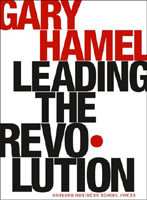
|
 |
Leading the Revolution Gary Hamel 
Format: Hardcover, 336pp. ISBN: 9781578511891 Publisher: Harvard Business School Press Pub. Date: Rev&Updtd edition October 2002 Average Customer Review: For Bulk Orders Call: 626-441-2024 Description and Reviews From The Publisher: Gary Hamel, world-renowned business thinker and coauthor of Competing for the Future, the book that set the management agenda for the 1990s, now brings us Leading the Revolution. An action plan--indeed, an incendiary device--for any company or individual intent on becoming and staying an industry revolutionary. This book will ignite the passions of entry-level assistants, neophyte managers, VPs, CEOs, and anyone else who worries that their company may be caught flat-footed by the future. Hamel argues that in an increasingly nonlinear world, only nonlinear ideas will create new wealth. To thrive in the age of revolution, companies must adopt a radical new innovation agenda. The fundamental challenge companies face is reinventing themselves and their industries not just in times of crisis--but continually. Based on the experiences of world-class companies including Charles Schwab, Cisco, Virgin Atlantic, Disney, and GE Capital, Leading the Revolution explains the underlying principles of radical innovation, explores where revolutionary new business concepts come from, and identifies the key design criteria for building companies that are activist-friendly. It will show companies how to avoid becoming "one-vision wonders"; harness the imagination of every employee; develop new financial measures that focus on creating new wealth; and create vibrant internal markets for ideas, capital, and talent. Drawing on the examples of activists who profoundly changed their companies with their bare hearts, Hamel outlines the practical steps anyone can take to lead a successful revolution in their own firm. With an arresting four-color design and a compelling message that will set the innovation agenda into the next century, Leading the Revolution is a call to arms for the dreamers and doers who will lead us into the age of revolution.
—Peter Schwartz, Chairman, Global Business Network Revolutionaries in the new economy are those leaders and companies willing to change the strategies that once made them great. Gary Hamel's clear and powerful blueprint for radical innovation is eye-opening for any business. —Michael Dell, Chairman and CEO, Dell Most people on the front line of business know there is a revolution going on, but wake up each day not knowing in what direction we are heading. That's what makes the current environment both frightening and exciting. Gary Hamel captures the moment with a no-holds-barred assessment of the issues facing companies all around the world as they struggle to catch up with the new economy. —Sir Richard Branson, Chairman, Virgin Group Gary Hamel captures the new competitive business environment, one in which dreams and reality merge. Leading the Revolution will inspire innovation at all levels and provide insight into opportunities for rewarding revolutionary thinking in new and bigger ways. —Arthur M. Blank, President & CEO, The Home Depot, Inc. Gary Hamel's 'revolutionary entrepreneurship' model represents a substantial advance in our understanding of what companies must do to become outstanding innovators. It should influence not only top management but also all employees who are, indeed, the CEOs of their business lives. —Kenneth L. Lay, Former Chairman and CEO, ENRON As venture capitalists, we like to finance swarms of startups that kick the stuffing out of established companies. So please put this book down. Now slowly back away from the counter…. Because if you and your company put Hamel's revolutionary principles to work, it's going to be a lot harder for our start-ups to take your company by surprise. —Steve T. Jurvetson, Managing Director, Draper Fisher Jurvetson A fixture in the Harvard Business Review, and the man who introduced the phrase "core competencies" into the business lexicon, Hamel urges everyone, including managers of old-line companies, to lead a business revolution by fully implementing e-commerce, participating in cooperative techniques such as joint ventures, engaging in "co-oppetition" (selective cooperation between competitors) and taking advantage of the general upheaval in the marketplace. Hamel, a consultant on the faculty of both the London School of Economics and the Harvard Business School, makes his case forcefully and clearly: the "gale of creative destruction [theorized by economist Joseph Schumpeter] has become a hurricane. New winds are battering down the fortifications that once protected the status quo." The solution, he argues, is simple: imagine the kind of future you want for your company, then go out and create it. Businesspeople have to rethink everything they've ever learned, he argues, because firms will either become revolutionaries or will become irrelevant. In addition to cheerleading for change, Hamel fills his book with examples of companies large (Enron) and small (Sephora) that have seized huge competitive advantages by changing either their mission or the way business is done in their industry. Some of Hamel's fans--and they are legion--may be disappointed by this volume, however, because it co clearly echoes Hamel's earlier writings. Even so, his powerful presentation may well spur to action those not already familiar with his work. —Publisher's Weekly In 1994, IBM was a basket case. It had lost $15 billion over three years and watched its market capitalization drop by 70 percent, eliminating $73 billion of shareholder wealth. That was when a maverick named David Grossman emerged from an IBM outpost in Ithaca, N.Y., with the radical idea that IBM should become an Internet-savvy information services company. What followed was a remarkable guerrilla campaign to transform one of the world's largest companies. With the help of a sympathetic senior executive named John Patrick, as well as an underground network of far-flung Net-freaks throughout the IBM empire, Grossman overcame the odds and succeeded, helping to turn around IBM through his iconoclastic efforts.
Gary Hamel wants you to do the same thing. He doesn't care if you work for Cisco Systems in Silicon Valley or a Rust Belt widget maker in Youngstown, Ohio. If your work seems dumb, if your company seems brain-dead, if most of your waking hours aren't filled with the ardent pursuit of radical innovation, Hamel wants you to start fomenting revolutionary change to save your employer from the long, grim twilight of obsolescence. He wants you to think big thoughts, take chances and, most of all, care passionately about how it all turns out.
Hamel's new book, Leading the Revolution, purports to be a kind of Rules for Radicals, a once-fashionable work by the late Saul Alinsky. But instead of empowering society's downtrodden, Hamel wants to convince you that you already have the power to pursue "business concept innovation" of the kind that turns industries - and possibly even societies - upside down.
At this point sensitive readers may feel as if they've wandered into Charles Saxon's famous 1972 New Yorker cartoon about a party. "Steer clear of that one," one woman cautions another about a man across the room. "Every day is always the first day of the rest of his life."
Corporations, after all, do not typically welcome borderline insubordinate campaigns by low-level employees to radically alter the direction of their business. Media critic Ben Bagdikian might have been talking about the difficulty of drastic, bottom-up innovation at most large companies when he said: "Trying to be a first-rate reporter on the average American newspaper is like trying to play Bach's St. Matthew Passion on a ukulele."
Aside from the inherent improbability of his argument, Hamel has a couple of other things going against him. For instance, he's annoyingly impressed with himself, as is evident from the book's self-dramatizing preface. And he's a management guru by profession (his last book was Competing for the Future), which to some readers will make him seem something of a charlatan by definition. Full disclosure: As a species, these guys drive me up a wall. If they really know so much, why haven't they started a few multibillion-dollar companies instead of preying on the insecurity of executives willing to drop a few bucks on the latest management fad? These guys are always full of noisy brio as they lay bare the gross stupidity of corporate America, yet somehow the same corporate idiots who are staples of every consultant's books and videotapes have managed to create the largest, richest, most innovative economy in the history of the world. What an amazing paradox!
All that said, I've got to confess that I liked this book, and you probably will, too. I liked it for the same reason I like churches and synagogues: Because it's not that often, in this indulgent and therapeutic culture of ours, that we are called upon to be better than ourselves, and with admirable fervor this is precisely what Hamel does. Indeed, the single best thing about Leading the Revolution is its radical argument that work should be engaging, meaningful and passionately performed, and that the way to accomplish this is not by taking pride in some minute increase in efficiency but by coming up with radical innovation - in other words, by being really, really creative.
Fortunately, Hamel goes beyond mere exhortation to offer a blueprint for how to revolutionize your company, even if it means cannibalizing an existing business.
First you need an idea, and some of his suggestions for developing these are obvious: Read new magazines, meet new people, visit new places. Yet it's equally obvious how few people follow them. The point is to find and exploit giant social discontinuities, such as the refusal of baby boomers to grow old (which has created markets for oversize tennis rackets, parabolic skis and other never-say-die products). Hamel emphasizes both direct experience and deep study: Go and see how other people live, but make sure you get beyond first impressions. And distinguish form from function: Banking, for instance, may be essential, but banks aren't.
The goal is "not to speculate on what might happen, but to imagine what you can make happen," and along these lines Hamel offers a section called "How to Build an Insurrection." First you need a point of view, the equivalent of an ideology, but it must be "credible, coherent, compelling and commercial." Then write a manifesto, create a coalition, pick your shots, co-opt and neutralize opposition, find a "translator" to bridge the gap between revolutionaries and establishment, start building small victories, and stay underground long enough to build critical mass - but then be sure to infiltrate (rather than overthrow) the highest levels of the organization to win the resources you'll need to realize your vision. (If you're in senior management, don't feel left out; Hamel suggests ways to make your company revolution-ready.)
Leading the Revolution offers a wealth of stories along the way about people and companies who managed to create the kinds of revolution the author is calling for. And although he gives too little credit to the people in white lab coats, he's basically right that a lot of wealth has been created by the Gap, General Electric, Starbucks, Wal-Mart and other companies whose earth-shaking innovations--people will pay $4 for a cup of coffee!--did not require an engineering degree. In one of his best examples, the brainstorm of a twentysomething Enron employee in England quickly led the company in a whole new direction. "Enron went live in November 1999 with one of the first online markets for all forms of energy," Hamel writes. "Just months after its launch, EnronOnline was doing a dollar volume far greater than Internet stars like Dell Computer, Cisco or ..."
Or consider Ken Kutaragi, an obscure Sony researcher who almost single-handedly got his company to come out with a videogame system in 1994. "Less than five years later," Hamel writes, "the PlayStation business had grown to comprise 12 percent of Sony's $57 billion in total revenues, and an incredible 40 percent of its $3 billion in operating profits."
Hamel's examples show that, when the planets are aligned right, it really is possible to bring about revolution inside a company. That doesn't mean it's possible for all of us, or even most of us. But I agree that in the absence of passion and creativity, work is mere drudgery, and Hamel makes a strong case that bringing fresh thinking to the job can produce wealth as well as satisfaction - no surprise to those directly involved in the Internet revolution.
Perhaps, though, the ultimate message of Hamel's book is that in business the phrase "after the revolution" no longer has meaning, ironic or otherwise, since the revolution he's talking about is one without end. —TheStandard
About the Author Gary Hamel is a founder and chairman of Strategos, and Visiting Professorof Strategic and International Management at the London Business School. He is the co-author of the international bestseller, Competing for the Future. Table of Contents
Find Items On Similar Subjects |
|

Books by Gary Hamel LEADERSHOP 
The Essential Lists BOOKS TO READ BEFORE YOU LEAD 
Grow Your Leadership Skills NEW AND UPCOMING LEADERSHIP BOOKS 
Classic Leadership Books BOOKS TO READ BEFORE YOU LEAD |
 |
| ||
 | © 2019 LeadershipNow All materials contained in https://www.LeadershipNow.com are protected by copyright and trademark laws and may not be used for any purpose whatsoever other than private, non-commercial viewing purposes. Derivative works and other unauthorized copying or use of stills, video footage, text or graphics is expressly prohibited. |
||